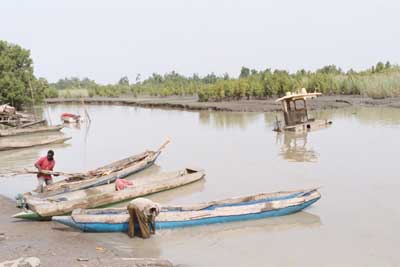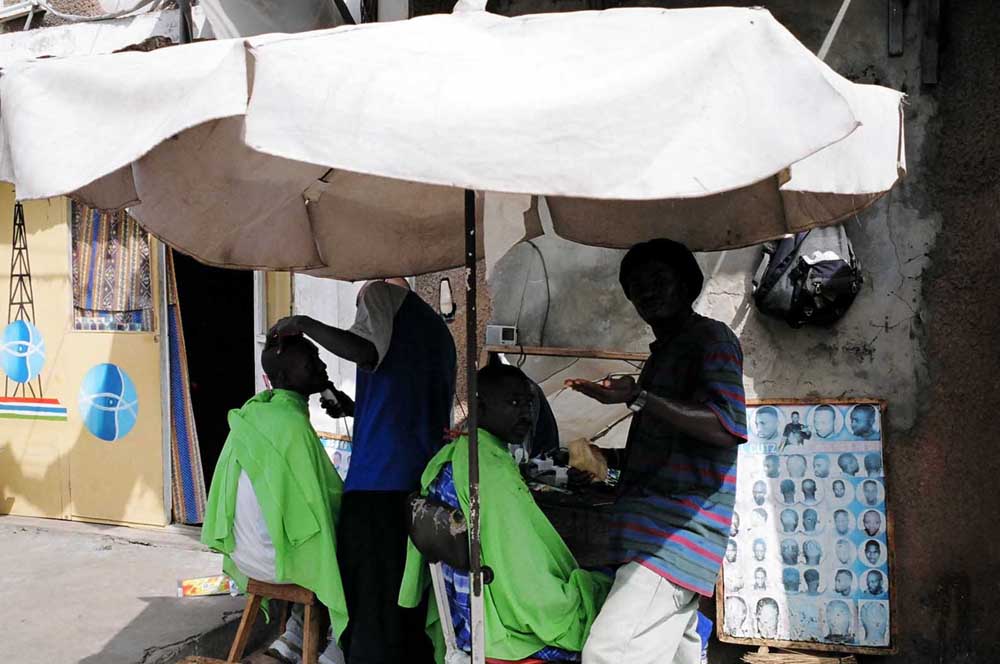 |
A Barber of Banjul.
This is on the streets of Banjul, the capitol of The Gambia.
There is a tarpaulin over the shop,
and the sun beats down mercilessly upon
the street. It is about 90 degrees (F) that day.
|
 |
My cousin Ray has engaged 17 children just outside of arch22.
Minutes later of course a Vendor will be asking us to buy
things - capitalism at work.
When I return from the top of Arch22, we give away 1/2
a pile of tissue paper.
Now, giving away tissue paper to a westerner would be
insulting. But these kids were more than eager to
receive it. They were ready to kill for this tissue
paper. A pack of hungry wolves descended upon the
tissue paper and it vanished in a puff of snarled
fingers.
|
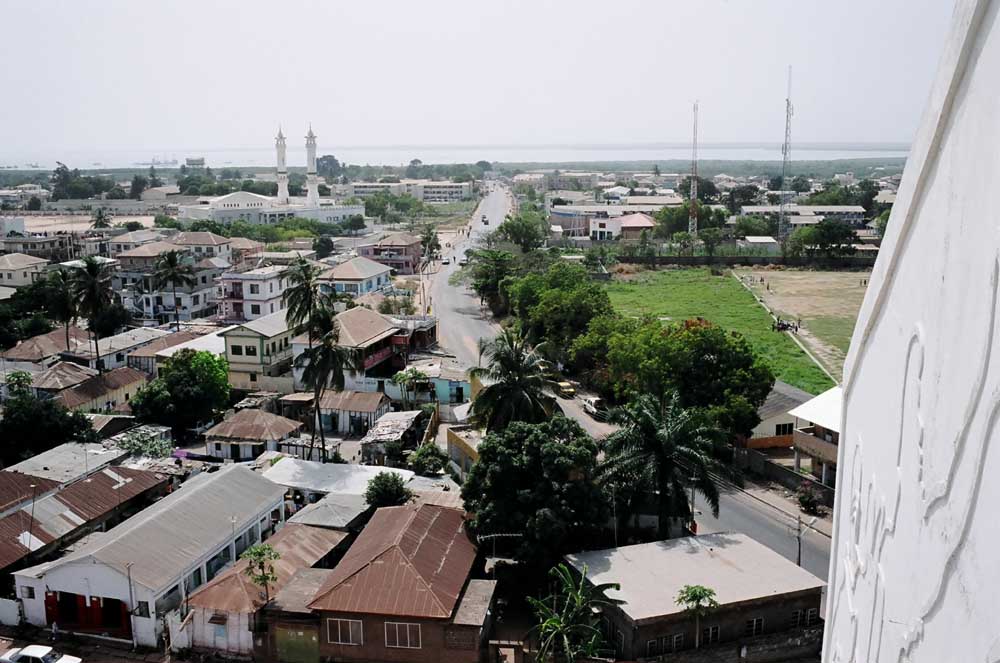 |
This is a picture overlooking the dusty capitol city of Banjul. Notice the Mosque in the
backdrop (on the left).
(History) 90% of the country is Muslim,
a consequence of the Soinke-Marabout civil war.
In 1850, the Muslim villages (Marabouts) declared a holy war
against non-muslims (the Soninke). Then, thousands
of Fulani Muslims invaded.
(Modern Muslim country) Today, the country is Muslim.
In Gunjur, the entire town stopped for a
midday 2PM prayer. An Imam led a prayer
via loudspeaker. Everyone stopped,
opened a mat, faced east, and prayed.
They touched forehead to ground several times.
Schoolchildren learned from the koran.
(Modern Capitol & Developing countryside)
Gambia as a developing country is poor, but their capital is modern.
Notice to the right of the picture the television station.
There is only one station in the entire country,
serving about 5,700 televisions for a population of 1.54 million.
Really, only the capitol and a few surrounding cities have
television reception.
|
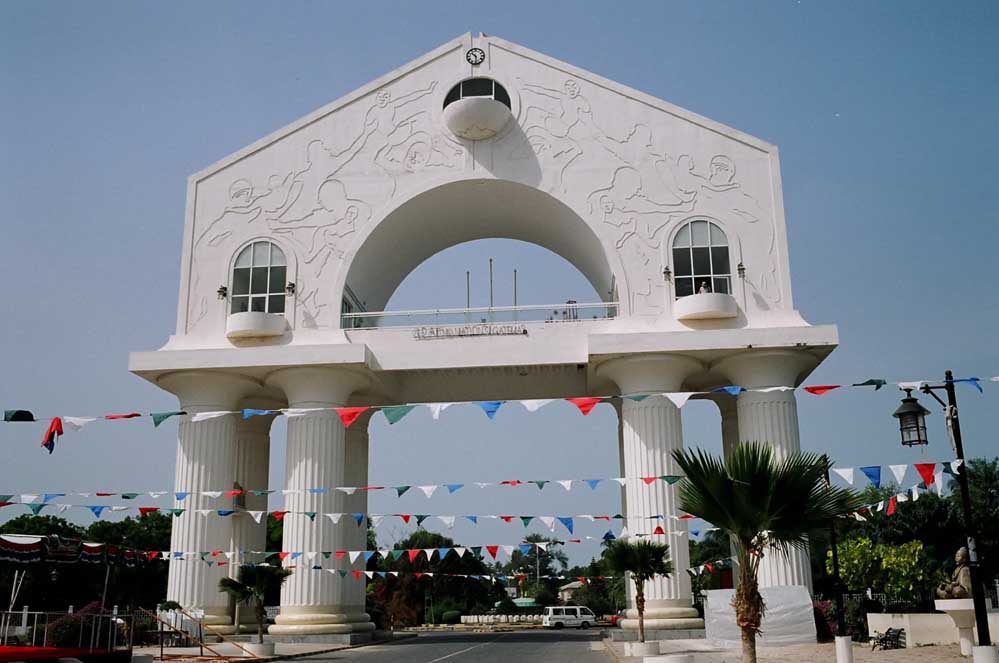 |
This is the Arch 22 Monument. I paid 50 dalasi to
enter ($1.70 USD). At one point the spiral staircase
was so dark I had to break out my LED flashlight which
I had attached to my belt loop. The top of Arch 22
promises a beautiful vista over the capitol of the Gambia
and was well worth the sweaty climb.
|
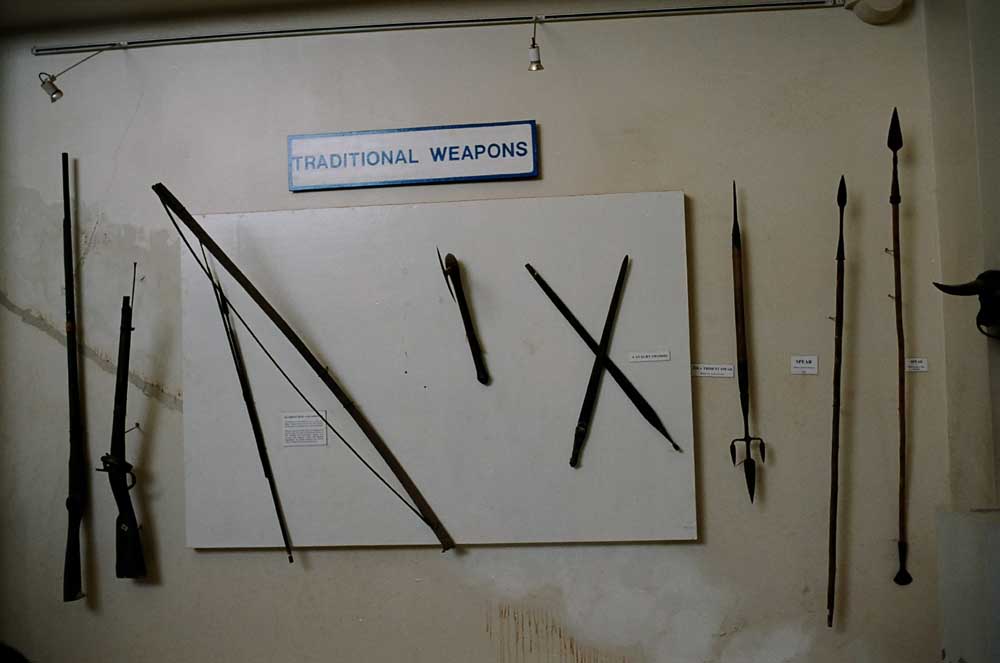 |
Pictured here are traditional weapons. This was a
little museum at the top of Arch 22. A load of
farangs had just been disgorged from a tour bus. The
country receives 2000 international visitors a day,
they have to go somewheres and most of them visit
Arch 22. As you move out further east there are
fewer and fewer westerners. By the time, we reached
Basse Sante Su we were the only ones. The weapons
have been modernized unlike most of the rest of the
country. The police and soldiers all use pretty
modern looking rifles/guns.
|
 |
Pictured here are traditional tools of agriculture.
More insightful though was when I got a chance to
discuss with a person from Taiwan at JanJang Bureh
(Georgetown). Because I speak fluent mandarin I was
able to find out a lot. Taiwan has donated their
agricultural knowledge to bring modern tools and techniques
to this country. Mr Cheng told me that the people are
lacking in knowledge of proper nutrition. The people
appear vigorous and have a super physique, but if confronted
with a minor illness their poor nutrition shows through.
This was also borne out by the meals that I had,
lacking in fruits and vegetables. They ate
an extremely narrow diet of ground nuts, bananas,
bread, rice with spices, and watermelon. Though they
had varying combinations of the above. For example
I had a ground nut sandwich (bread) with spices.
I had a meal consisting of rice with spices and bread.
A fascinating passage in the lonely planet guide to
Gambia went like this : "A western restaurant owner
had an argument with her chef. The patron had asked
for a vegetarian meal, but the chef put in beef in
the dish. The owner angrily stormed in and asked
why beef was put in the dish. The chef said if you
can afford to eat beef then you should!". It illustrates
a difference in thinking. The chef could not understand
how someone could be a vegetarian if they could afford
to eat meat. In the west, the land of plenty, a
vegetarian can get sufficient sources of protein to
substitute for meat. In the Gambia there is only
meat or no meat. Well, there are ground nuts but
after eating a few pounds of those you get pretty tired
of them. Mr. Cheng also explained to me a perennial
problem of helping the poor. If you give they will
take. But if you only give they don't improve. You
must learn to teach before they can help themselves.
At first the Taiwan government was only giving money
aid and tools. Then they learned to set up classes,
and lease equipment, giving the locals an incentive
to actually learn and work.
Another interesting fact was that before Mr. Cheng
(Taiwan) arrived and showed them modern irrigation
they would only plant and harvest with the seasons.
This had been going on for hundreds of years. A
reader of this might ask : "why haven't didn't they
learn irrigation before?". Many reasons, keep in
mind slavery itself was only abolished in 1807
(millions of Gambians were enslaved by whites),
then in 1850 the Marabout-Soinke civil war occured.
In 1941-1946 (during World War II), european powers
carved up and controlled Africa.
Only on Feb 18, 1965 did the country
gain independence to join the commonwealth of the UK.
And finally on April 24th, 1970 the Gambia becomes
a republic, and a wholly independent country.
They are still incredibly poor, massively illiterate,
religiously driven, and are only now just picking
up the skills the West mastered 1000 years ago.
|
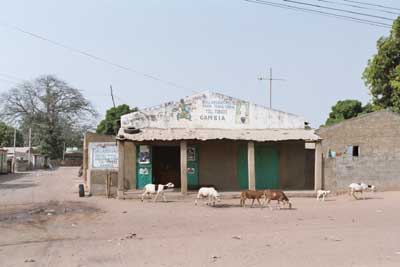 |
This was one of two hotels (guesthouses) in
Farafenni. We stayed at Eddie's just around the corner.
We had a soda just across the street from this hotel.
I like this picture of goats cross in front of a hotel,
where can you see that in America?
|
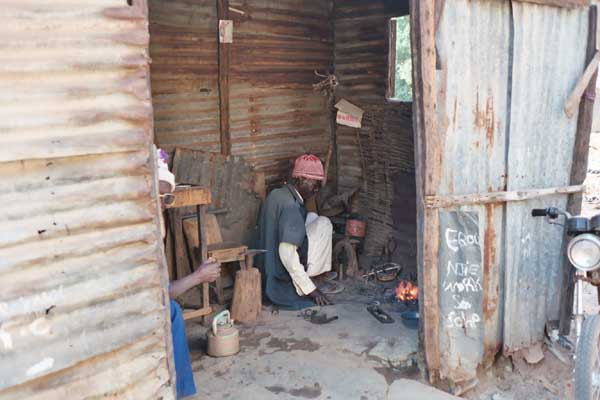 |
This amazing one man smithy is a little self
contained industrial revolution. His metal working
skills allowed man to rise above the monkey.
He has all the capabilities to work metal in this
little hut. A tiny blow furnace to heat coals.
A slab of metal(s), and a quenching cup. Tempered steel
is produced by quenching the metal as it starts to
cool. From red-white hot down to a blueish color.
Just at the right moment(color) you drown the metal
in cold water. This put a protective oxide layer on
the metal , and if cared for will last your lifetime.
The smithy here is making Solder. Just minutes later
a person with a radio will walk up and dip a metal stick
with hot solder on it in an attempt to fix a radio.
Around the corner from here a lady is setting up
shop. She cuts in half a watermelon to sell.
She has a baby slung on her back. The average women
has 5.4 children in the Gambia.
|
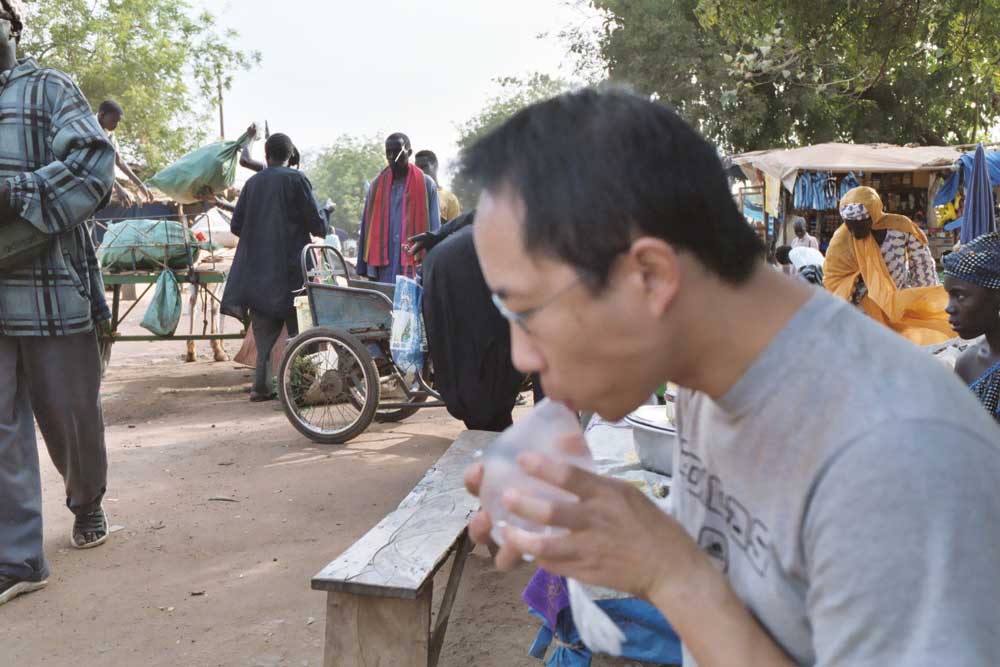 |
This is the first third world country I visited
that didn't have bottled water. This baggie of water
is prevelant around the entire country, and cost 1 Dalasi
($0.03 USD). You have no idea where this water is from,
but you also have no choice. It isn't brown , doesn't
taste polluted and we didn't get sick from it.
|
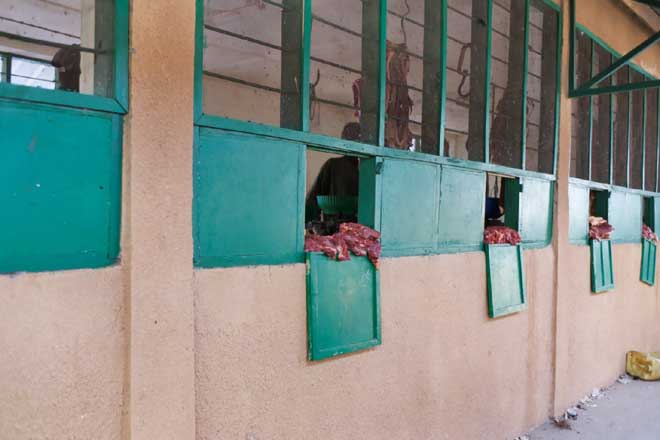 |
Farafenni is a market town. People come from all
over the countryside to this market. There are perhaps
100 little stalls and stands. Each person or two is
a little store. There are actually standing stores
with 3 walls, but perhaps only 30 of those. The ground
is dirty, and dusty. And pictured here is rotting
fly-ridden beef for sale.
|
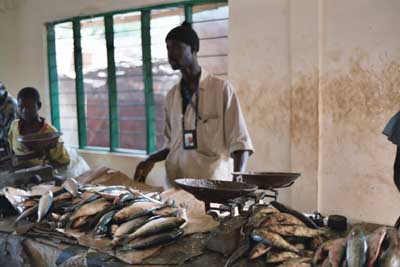 |
At this fish market store just down from the Beef store,
about 7 vendors are selling fish. I ask how much they
are , this man says 4 fish for 10 Dalasi ($0.34 USD).
This is also fly-ridden fish, smelly and rotting in
the open.
|
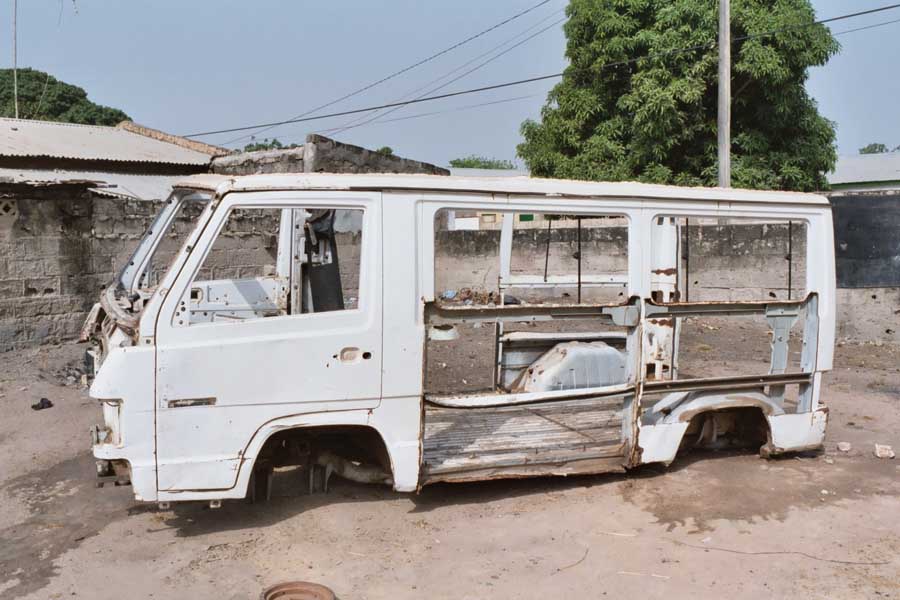 |
Pictured here is a husk of a car. Similar to the
Minivans that we will use to traverse the country.
Small crowded and used to death. Afterwards they meet
a scavenger's death as usable parts are recycled
into other vehicles.
|
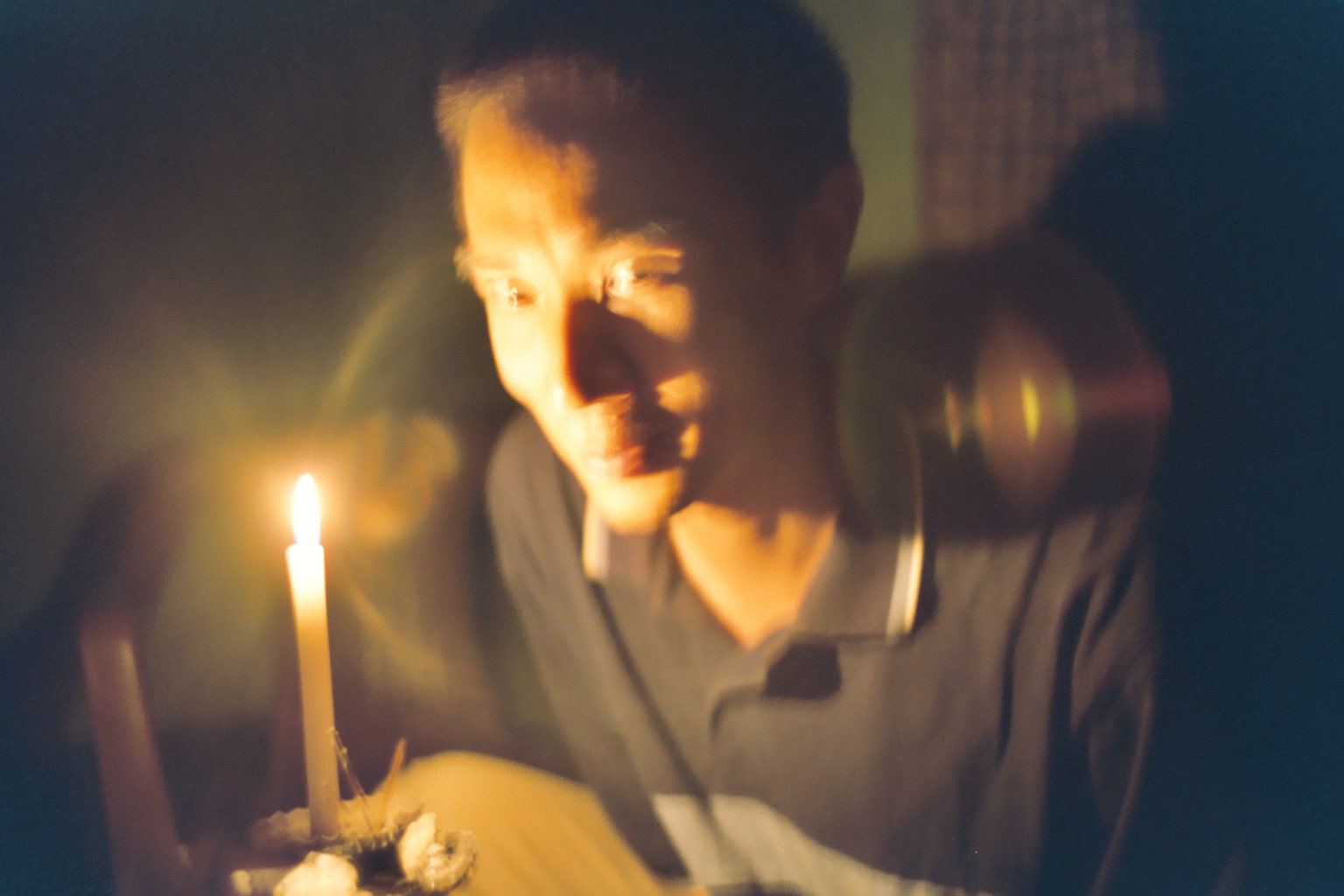 |
This picture of me next to a Candle has a
long story behind it. We had travelled across the
entire country to get to Basse Sante Su.
Starting at Banjul we went to Barra (by ferry), then
by Minibus went to Farafenni. Stayed the night at
Farafenni, and the next day checked out the markets.
Then went to Yeletenda took a small ferry, then
a harrowing taxi ride to Soma , and then to Basse Sante
Su.
During the trip,
I made friends with a government worker named
Mohammad, he told me what it was like to work
for the government. He deals with the export market
(ground nuts). He helped us find Basse Guesthouse
in the dark when we arrived at Basse Sante Su.
The hotel owner, candle in hand found room number 2,
stooped down with candle unlocked the room, and
then walked to the center and lit the tiny candle
in the middle of the room with her candle. A candle
light stay. It was hot in the room, probably about
95 degrees. We couldn't sleep. We opened the windows.
We sae someone outside with a flashlight. Thinking
we might be robbed we moved our backpacks around.
We tried to sleep. I think I got 1 or 2 hours of sleep.
I woke up to the fzzfzzzzzzfzzzzzzzzz of a mosquito.
That's right the room had no electricity, it had no
fan, and no screens on the window.
We paced around outside to avoid the mosquitoes
for hours. I'm exhausted.
We discovered about 40 mosquito bites on each of
us the next day.
I half slept on the porch in the cool, brisk
pre-dawn air. It had enough wind that there were
few mosquitoes and I half slept/sat in a chair
the rest of the night. That was by far
the most horrendous car ride and most horrendous
bug-ridden night of my life.
|
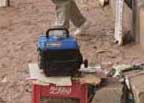 |
The rest of the
nights in the Gambia weren't so bad. We found
good guesthouses with screen windows and fans.
Perhaps the Atlantic hotel in the Capitol
had electricity 24/7.
But most hotels had electricity like 4/7
(using portal electric generators). That is,
most hotels had electricity for about 4 hours
in the evening from 8PM - 12AM. It was too
expensive to run them all day. Gas cost about
25 Dalasi per Liter ($3.25/gallon).
Basse guesthouse had electricity 0/7.
In other words, no electricity at all!
Pictured here is me next to an electric generator.
|
 |
The following pictures are from the village
of Kerewan Badala. Here we were warmly greeted
by the villagers (who of course wanted money). But
we got to see how they lived, where they lived and
asked them numerous questions about their lifestyle.
We essentially got a guided tour of the village.
We gave the about 500 Dalasi (a small fortune), but
converted to US dollars that's $17.0.
|
 |
The trip to this village was a wonderful experience.
Kerewan Badala is a typical Gambian village,
a place where radio hasn't reached, a place where
Television, electricity, the automobile, hair dryers,
and saturday morning cartoons don't exist. You have
stepped back in time 400 years by visiting any of the
hundreds of Gambia villages. They are easy to find
they are all over the place. In fact, Kerewan Badala
we weren't looking for specifically we just walked into
the village from Basse Sante Su. We saw villagers making
flour from wheat (in a 3 feet Mortar and Pestle).
Crops everywhere (this is living by subsistence
farming), chickens running around (for meat/protein).
|
 |
Yes, this lady's son (on the right) here is
naked. You think the Europeans are liberal about
clothing? Ha! I saw loads of naked people in
the Gambia. One that sticks out in my mind was a
restaurant we walked into in JanJang Bureh. A
mom and pop restaurant. We walk in and the Lady
is topless carrying a naked 1-1/2 year old baby.
Some of the children
had never seen an Asian person (because we were called
"White"). Most of the teenagers knew who asians were
probably because of the Taiwan agriculture
project and Japanese fishing project.
|
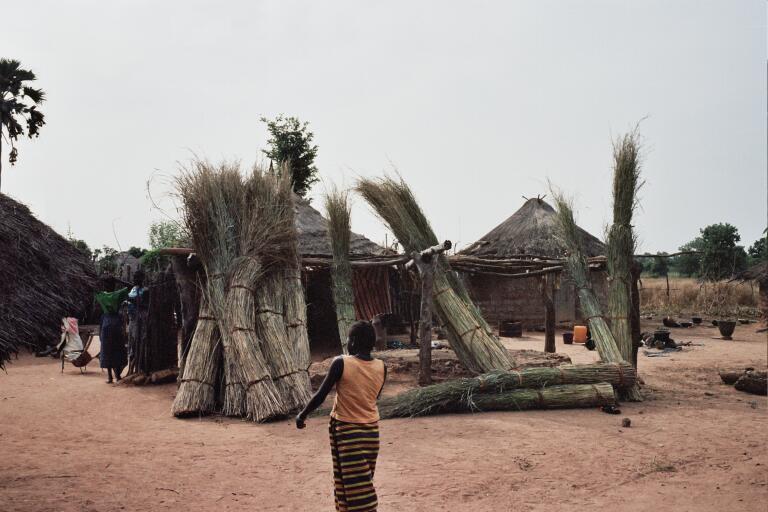 |
These straws I think are the roofing material
for the huts.
|
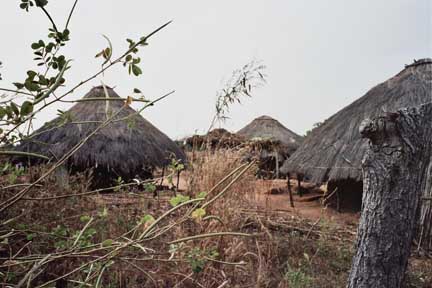 |
Have you ever wanted to live in seclusion
from the modern world? Have I got a place for you.
Grow your own food, live off the land, no contact
with the modern world. Ok you have to go to the
bathroom in a stinky hole in the ground, and
there is no radio, TV, internet, books, refrigerators,
automobiles, hairdryers, alarm clocks to bother
you. Only lots of hard sweaty work in 90 degree heat
warmly greets you.
|
 |
This woman and her children were very nice.
We accepted their address and promised to mail
her photos. Note that he hut is about 8 feet
tall at the top of the cone. So a person could
stand up in it. It is about 9 feet in diameter and
the bed takes up about 1/2 of the space (as seen in the
picture). This person owns very little in the way
of material goods.
|
 |
Another shot of Mrs. Jallow.
Her daughter Maimuna, gave us their address:
Maimuna Jallow
she is a student
from Fulladou East District
in Basse Kerawan Badala
Alkalo is Sibitenden Jawara
Basse Sante Su
The Gambia, West Africa.
(BTW a Sibitenden Jawara is a tribe leader)
As you can guess letters are almost non existent
here. At one point in the trip we saw a letter
being delivered from the minivan that we were
in to another person on the street. It took a whole
5 minute conversation and stopping in the middle
of the highway to hand off this letter. Forget mail
trucks, forget the internet. This village receives
a letter a month, if that.
|
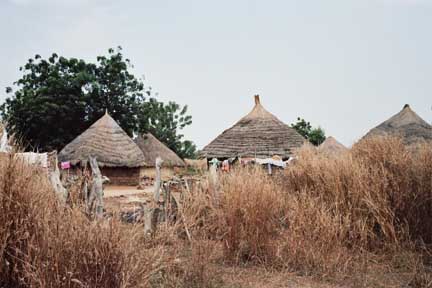 |
Seen here clothes drying on a dry line.
Daily chores take a tremendous amount of time - from
washing clothes, to growing food, converting food into
an edible form, cooking meals after conversion, and
on top of that trying to make some money selling
goods/wares/food to the nearby town of Basse Sante Su.
|
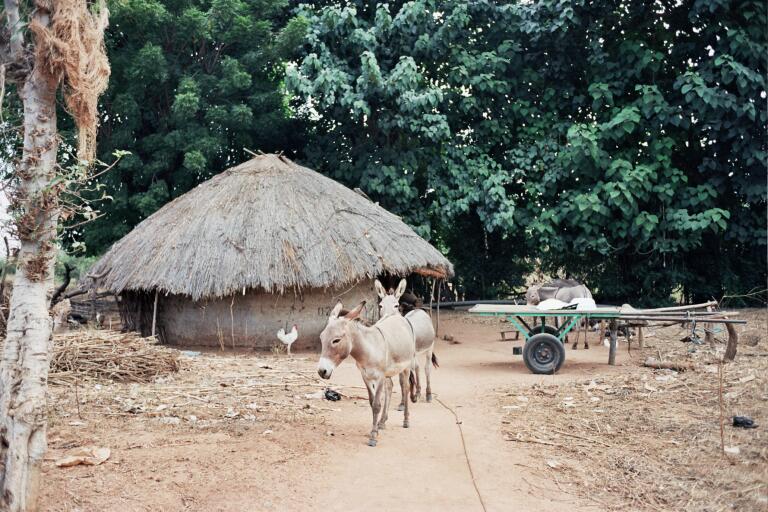 |
Pictured here in Kerewan Badala village some donkeys
next to an Ox Cart
|
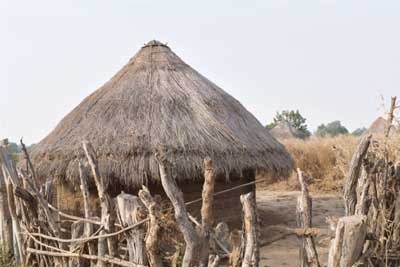 |
Every person you bump into in the Gambia is looking
for a way out of their situation. And will try to
hoist onto you their address in the hopes that you
will sponsor them in school, or give them money.
The median age in the Gambia is 17.4. So most people
are young. Poor nutrition will not bother you when
you are 20, it kills you when you are 50. In fact
the life expectancy for a Male is 52.8, for a female
56.8.
|
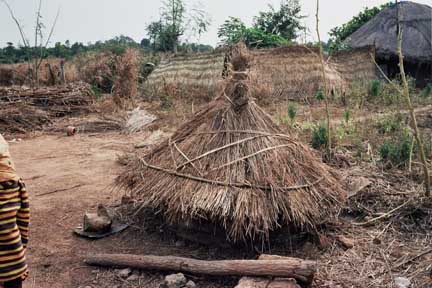 |
This rather odd looking little hut is a
slow cooking oven. On the inside are stones
and blocks arranged in a fire proof way.
|
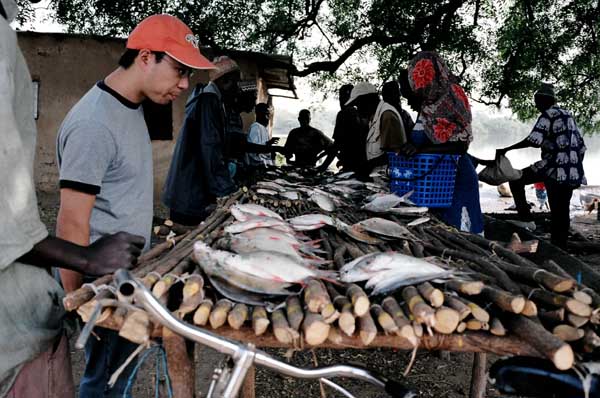 |
Here are some fish that have been caught
by the Jan Jang Bureh village. They are sold
in the open air on a wooden rack. Interestingly
enough, there a few insects, though this does
smell pretty fishy here.
|
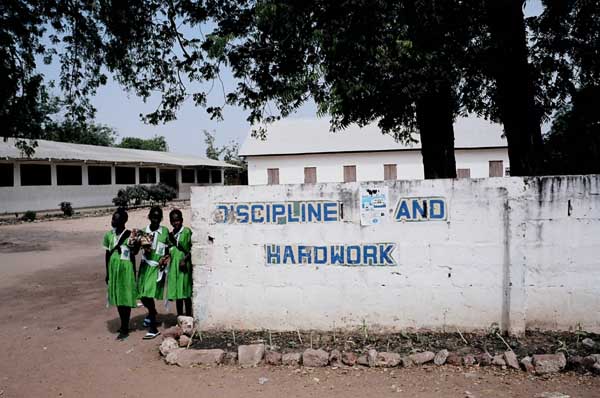 |
This is a school in Jan Jang Bureh , the
town. It is attached to a Mosque next door.
All the children wear uniforms. Children go to school
(learning from the Koran) for 1/2 a day.
Most children can not afford the time to go to
school, as they are needed "down on the farm".
To get a high school degree is a great achievement
in the Gambia. A university degree is extraordinary.
Why? Because you have to travel to the Capitol ,
in Banjul to get one. And it requires many orders
of magnitude more money than the typical person has.
|
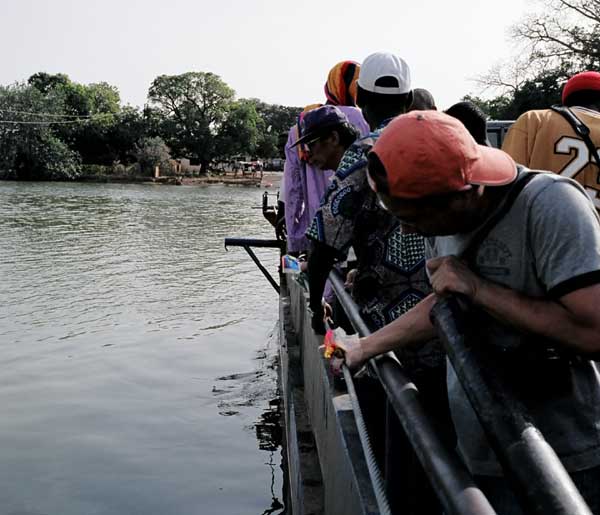 |
This amazing little ferry is hand powered.
It holds 2 automobiles, and about 40-50 passengers.
This cable in a guide rail gets the ferry across the
Gambia river. Pictured here is my cousin hard at
work, while I snap the photo. Just after I snap
this photo I will go back to pulling on the cable as well.
It is a thick 2 inch diameter cable. People use
pieces of plastic so they don't damage their hands.
|
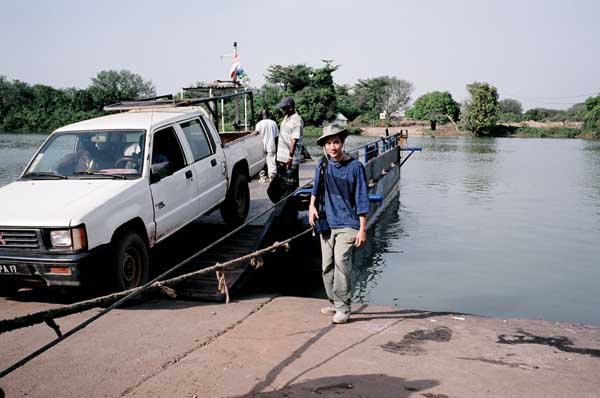 |
Here I am next to the hand-powered ferry,
from which I just disembarked.
|
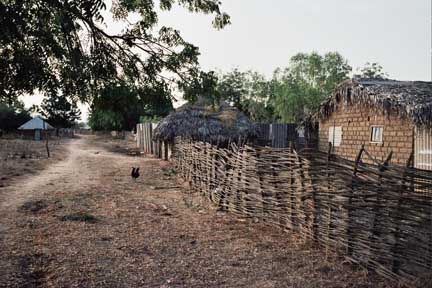 |
This is another village, called Jan Jang Bureh.
This is a smaller village than Kerawan Badala.
We are not here for very long (about 3 hours), and
it looks very similar to Kerawan (see above). Here
I am trying to take a picture of a family of chickens
(complete with Rooster, Hen and Chicks) but the chicks
and mom have dived into the fence just as I was taking
the picture.
|
 |
Here in JanJang Bureh village I am folding
Origami for the children.
|
| SLAVE HOUSE, Jan Jang Bureh
|
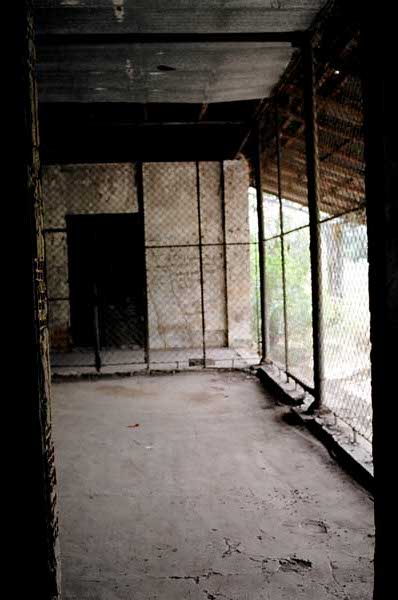 |
450 years of slavery plauged the Gambia.
The Portugese transplanted 4.5 million slaves,
and the British 2.5 million slaves. Then in 1807
the British outlawed slavery and actually protected
the Gambia from further slavers. So many slaves
had been transplanted from the Gambia that today in 2004,
20% of North Carolina African-Americans are of Gambian
descent. Alex Haley's novel "Roots" is set in the
Gambia. Following the movie Roots, the Gambia gained
a small spotlight, and therer was a surge of tourism.
Today (2004) about 100,000 tourists visit each year.
I was the 449th visitor from America in 2004.
(By comparison, the US gets about 38,000,000 visitors
internationally each year).
Pictured here is a cage within the slave house.
This is the first floor, and the cellar is also
a place where slaves were kept. This pen pictured
here is a completely enclosed metal cage.
There is only one entrance and about 4 rooms.
|
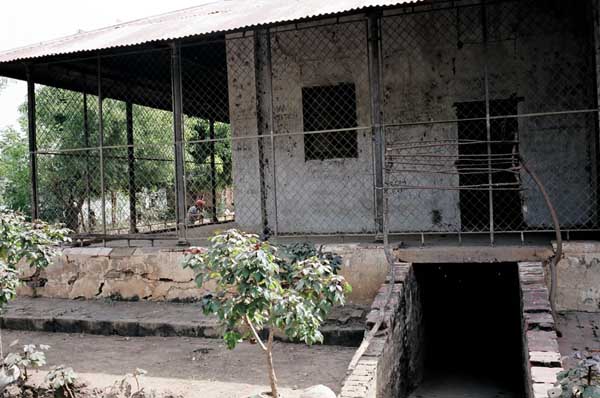 |
You can see the cellar here,
where slaves were kept. It is about 4.5 feet tall
(you have to stoop). There is a small water hole
where water would have been lapped up, food was
tossed down holes from the first floor, and another
small hole served as a communication hole. There was
also a section of confinement for the "agressive"
slaves (as the tour guide called them). And he showed
me manacles that were used to hold the agressive
slave in place. You can also see more of the first
floor cage.
|
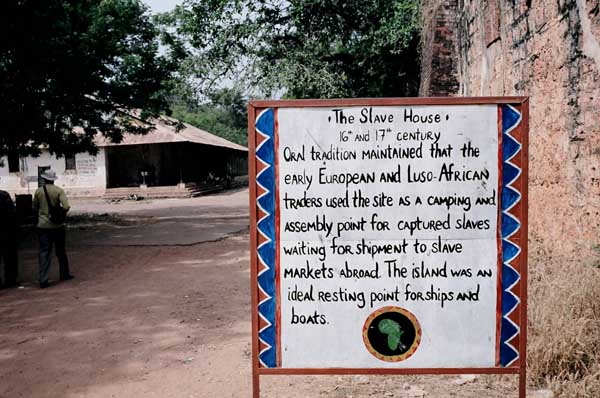 |
A sign describing the significance of the slave house.
Note the Slave house is on the left.
|
 |
The back side of the sign.
|
| WATER SAFARI, Jan Jang Bureh
|
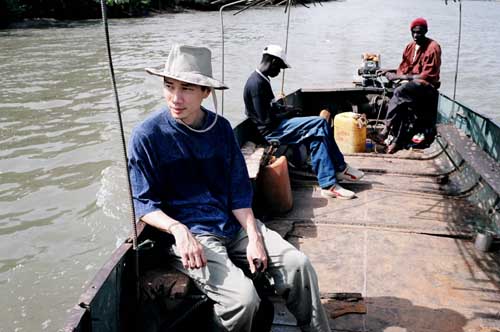 |
We went on a 4 hour water Safari from the BoBaoLong
guesthouse. We hired a tour guide and he arranged
for a boat trip the Boat Tour cost 1,400 Dalasi ($47.6),
and Sariff the Tour guide we gave him 500 Dalasi ($17.0).
This was rather expensive but considering we got a
private boat for 4 hours for two people with an
extremely knowledgeable guide, we made off pretty good.
This was, of course a small fortune for them.
|
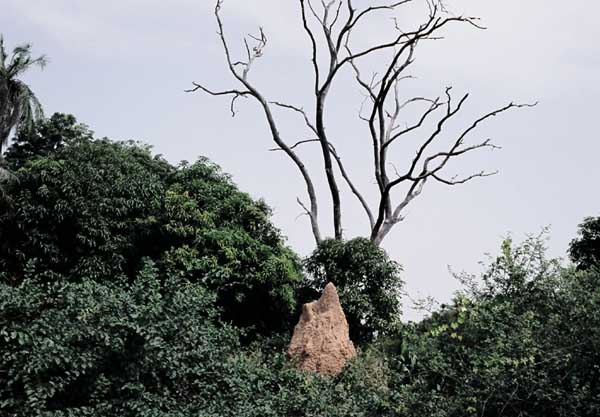 |
We saw lots of birds and the possibility to see
a Hippopotamus in the wild. But we didn't see a hippo.
We did see however this amazing 20 foot tall ant hill!!
These ants according to the locals are about 1/2 inch
long. This ant hill is abandoned. Notice the dead
tree eaten and stripped of life behind the ant hill.
We saw about 20 of these ant hills.
|
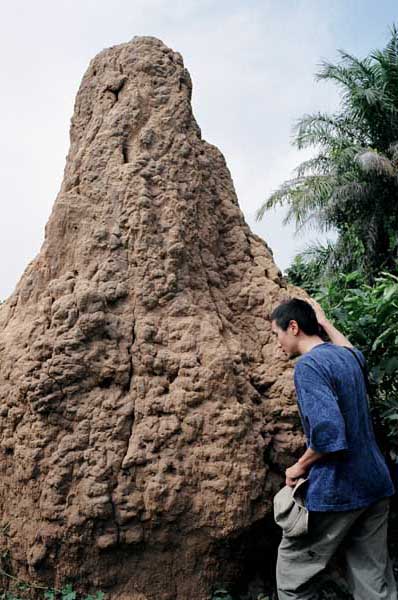 |
Here I am pictured next to an ant hill.
I am looking at a water duct of the ant hill
(see next picture).
|
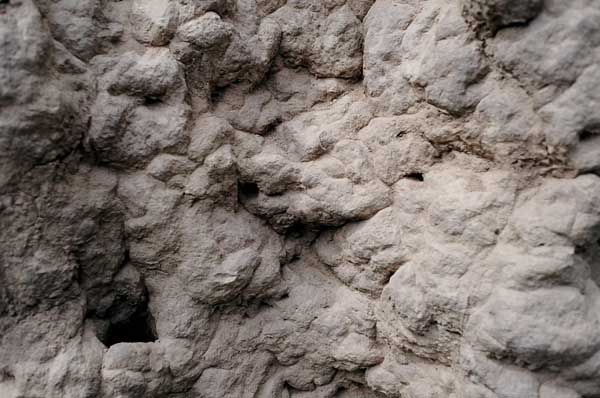 |
Here is a close up of one of the water drainage
ducts (about 2 inches in diameter). This duct carries
rain water away from the ant hill, so that the structure
remains standing even during heavy rains.
|
| in transit JanJang Bureh to Gunjur
|
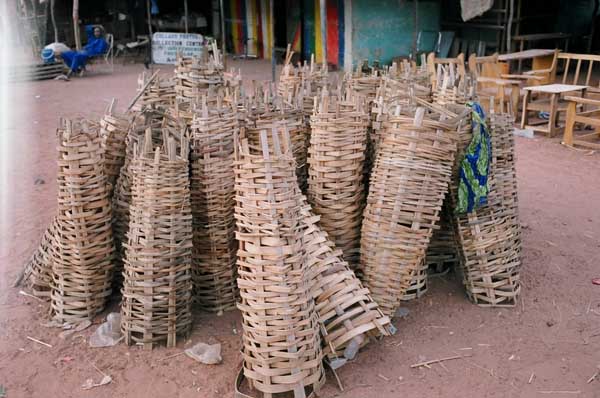 |
These hand woven baskets are placed
over crops so goats don't eat them.
|
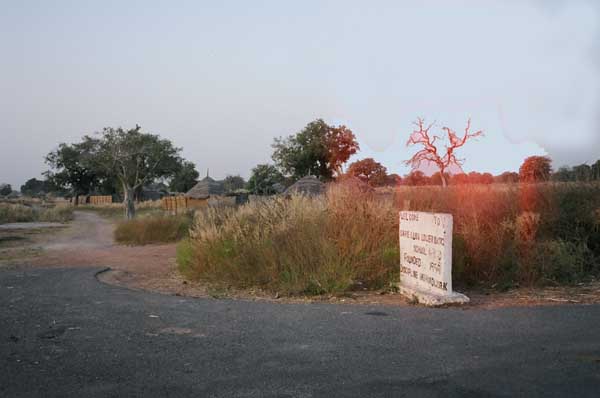 |
This collection of huts is a lower basic
(primary) school.
|
 |
Pictured here is a small girl whose name is
"Ho'wwa". She has balanced on her head a little plate
of nuts. Each one of these she will sell for 1 Dalasi
($0.03 USD). I bought 6 of them and tipped her on
top of that. As you travel across the country every
pitstop will have food vendors who wait along the side
of the road or at minibus stations all day long going
between minibuses selling food. But the products were
the same almost everywhere you went : Peanuts (ground
nuts), Watermelon, Water baggies, and Bread.
In Brikama, they sold cakes which were delicious.
Of the dozen or so times we stopped, Brikama
was the only variation on the nut-watermelon-water-bread
vendors there were.
|
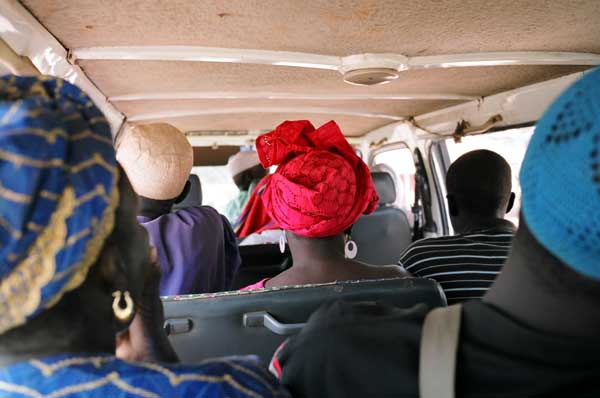 |
The "national highways" are a joke. There are
two of them the northern one and the southern one.
The northern one is unpaved, the southern one
was so full of potholes that you wished it was unpaved.
The potholes were the size of Jupiter. Well, ok
maybe just the size of Mars. But they were huge.
I mean really really car sized huge. They were so
big we NEVER drove on the road itself. In fact most
of the time we spend either entirely in the breakdown
lane (which wasn't paved), or weaving around like a
maniac trying to avoid the potholes. I felt like
I was in the video game frogger.
One-third of the time we spent on the
wrong side of the road trying to avoid potholes.
They usually drive
on the right even through they were a british colony
until Feb 18 1965.
|
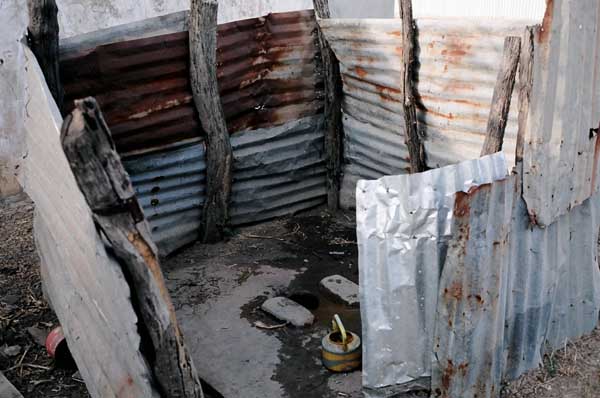 |
Pictured here is a typical toilet. This is
in Bansang. I used this toilet during a
minibus pitstop on my way to Gunjur.
This bathroom is actually shared by 4 families.
The little plant watering spout washes you off.
As far as I can tell there is no running water
down there, basically you just go in a septic
tank. It smells like 1,000 people flatuated
simultaeously.
It was a grueling and torturous 7 hour bus ride.
|
| REPTILE FARM, near Kartong
|
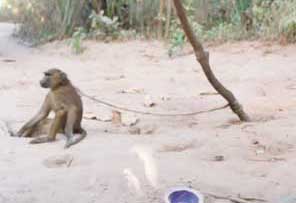 |
A pet monkey at the entrance to the reptile
farm. This monkey charged me, threw its bowl
at me and the sulked.
|
 |
Omar is holding a snake.
|
| KARTONG, The Gambia,
Border town with Senegal
|
 |
Kartong is a small border town between Gambia and Senegal.
We had to walk for about 30 minutes to get
to the border. The road well paved amazingly
enough, had almost no traffic. A cow lazily made
its way across the street. Pictured here is
a typical home of Kartong
|
 |
Pictured here are crops being grown,
Omar (our tour guide) told us what the crop was.
If I remember correctly, it was Couscous.
|
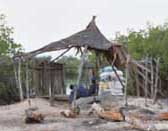 |
Casa Nosa was not easy to get to.
We had to hire a tour guide to get us there.
In the native language of Wollof he was able to
negotiate a private ride to Kartong, the
border town with Senegal. This is the only
place I have been where a border with another
country doesn't require visa/passport checks.
At least this is what the Lonely Planet guide said.
But on the way back the guard gave us a hard
time "How do I know you aren't terrorists?"
Our guide, Omar talked to the guard and allowed
us to BRIBE him for 50 Dalasi! This was the first
time in my life I have ever bribed anyone, let
alone a government worker/official/guard.
|
| GUNJUR, The Gambia, Fishing Village
|
 |
Pictured, a lady sorting some fish behind
the shadow of a boat. Trying to catch from
repreive from a merciless sun.
|
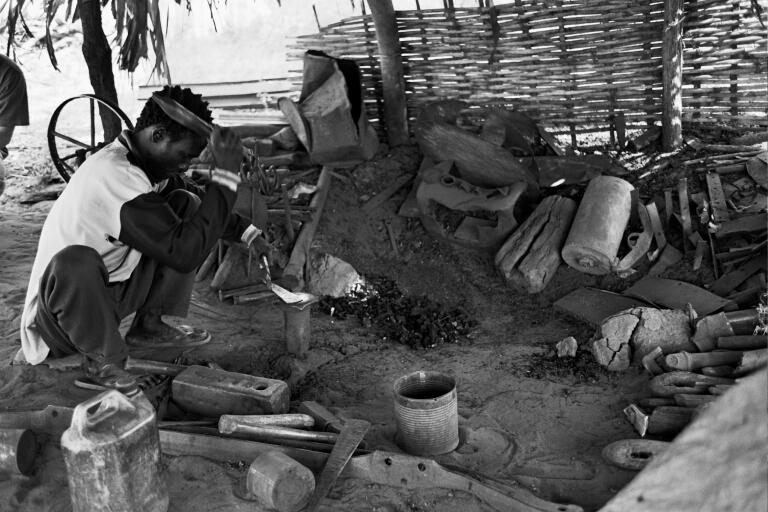 |
Here is pictured another one man forge
in Gunjur village. We watch him for a bit, he is
making an Ax head from which the villagers will cut
canoes from, cut wood for smoking fish, and
cut wood to make shipping crates to transport
fish in. His hammering on the metal is intolerably
loud. I can't stay for too long before I have to
leave the hut. TINK! TINK! TINK! He blows the
flames of the coals with a bicycle wheel.
|
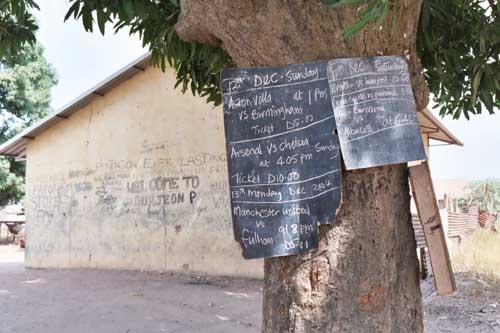 |
This is a movie house. The chalkboard
has the listing and prices of daily shows. The building
in the background is the actual movie house. Note
they are matches from England. Soccer (football) is
their pirmary sport, as it only requires a ball.
|
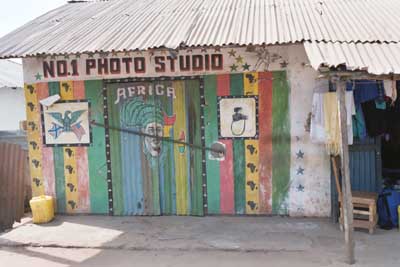 |
Pictured here is a photo studio in the
town of Banjul (distinct from Banjul village)
|
 |
A man is making a fishing net by hand.
It is quite a production, the making of fish nets.
Many people are involved in making them.
|
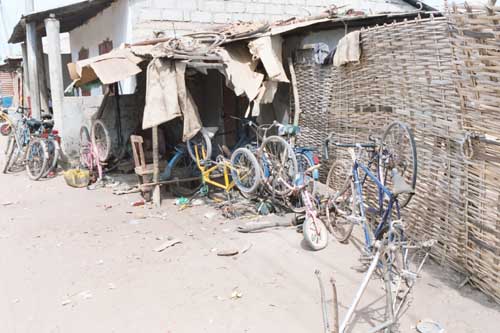 |
Here is a bicycle repair shop in Banjul town.
|
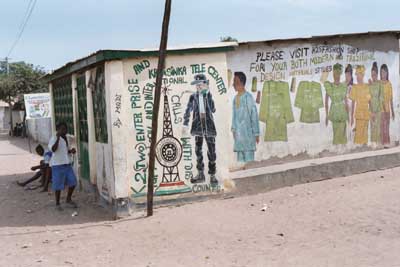 |
This is the telephone center in Banjul town.
To make a telephone call you need to travel to the
town center (from Banjul village this takes about
an hour and a half of walking). Then you can make
a telephone call.
|
 |
Pictured here is a ox cart
carrying a load into Gunjur Village.
|
| GUNJUR FISHING VILLAGE : The Fishing Process
|
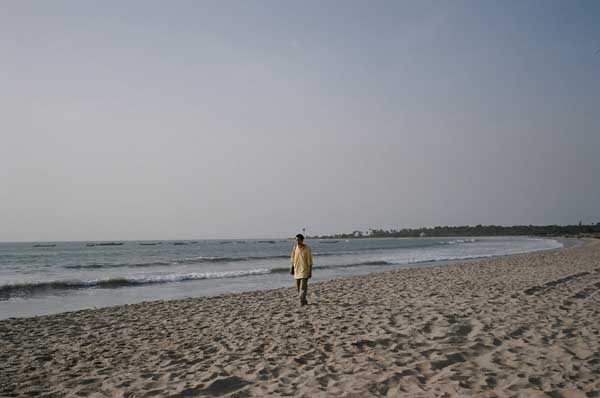 |
Gunjur village, is a fishing village
situated right on the Atlantic Ocean.
|
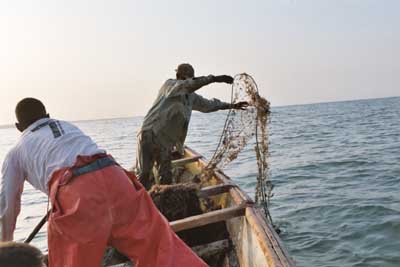 |
STEP 1:
The fish are caught.
We had Omar, our private tour guide from the previous
day arrange for us to get onto a commerical fishing
canoe. (Notice I didn't use the word boat). This
little canoe usually only holds 2. We wobbled our
way out to the nets (identified by a floating blue ball).
Then hauled in the nets and redeployed them again.
|
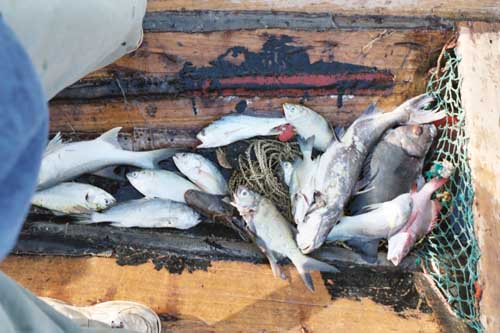 |
This 3 hour tour from the fishing
expedition above resulted in about 15 fish.
|
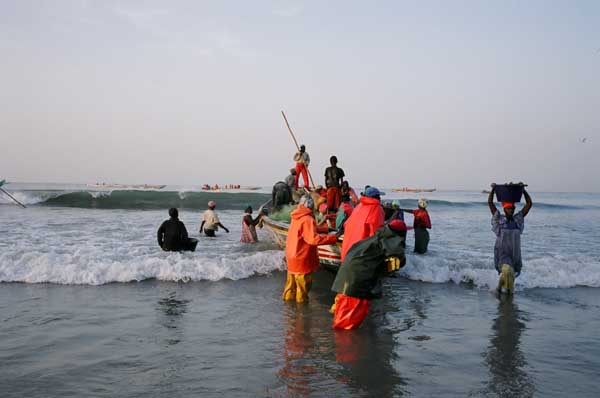 |
STEP 2:
The boats bring in the catch
|
 |
This is one of the larger boats, coming back
with about 60 fish.
|
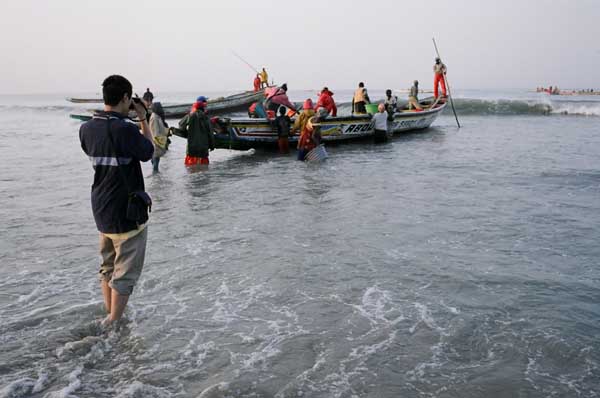 |
The price of photography, wet trousers!
Seejou a friendly local is holding my shoes.
|
 |
STEP 3:
Here the boats are being unloaded by
ladies who carry the fish on top of their
heads. Notice this lady isn't even stablizing
the huge basket of fish on her head!
|
 |
This picture was taken with a F-stop setting
of 5.8 at 1/125 of a second. I had metered off to
the distance, and then swung the camera into the sun
to produce a nice backdrop silhoutte image of a
fish-basket lady.
|
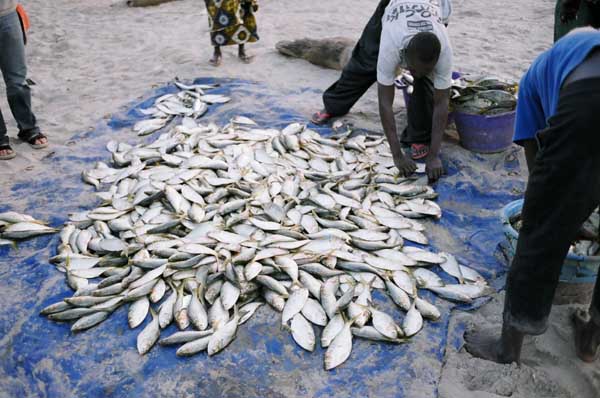 |
STEP 4:
The ladies take the fish and put them onto
a tarp. I'm told the typical worker here
makes about 25 Dalasi a day (that's < $1.0 USD a day!).
We met the "boss" later that day and gave a
donation to the village of 300 Dalasi ($10.20 USD)
|
 |
STEP 5:
The fish are laid out to dry in the sun
on large wooden racks.
I ask them why birds don't come down and eat
the fish, the locals tell me that humans are
constantly watching over them.
|
 |
STEP 6:
Next the fish are taken to a smoke house.
They are smoked using firewood and basically
cooked. In fact one of the locals lets me try
some of the fish, which is very good. These are
what they call "Bunga" fish.
|
 |
A close-up of the fish. This is
Black and White film. Though inside the smoke house
it is pretty dark (black) and the fish are white.
|
 |
STEP 7:
The last step, the fish are shipped
to other villages and markets.
|
| BANJUL INTERNATIONAL AIRPORT
|
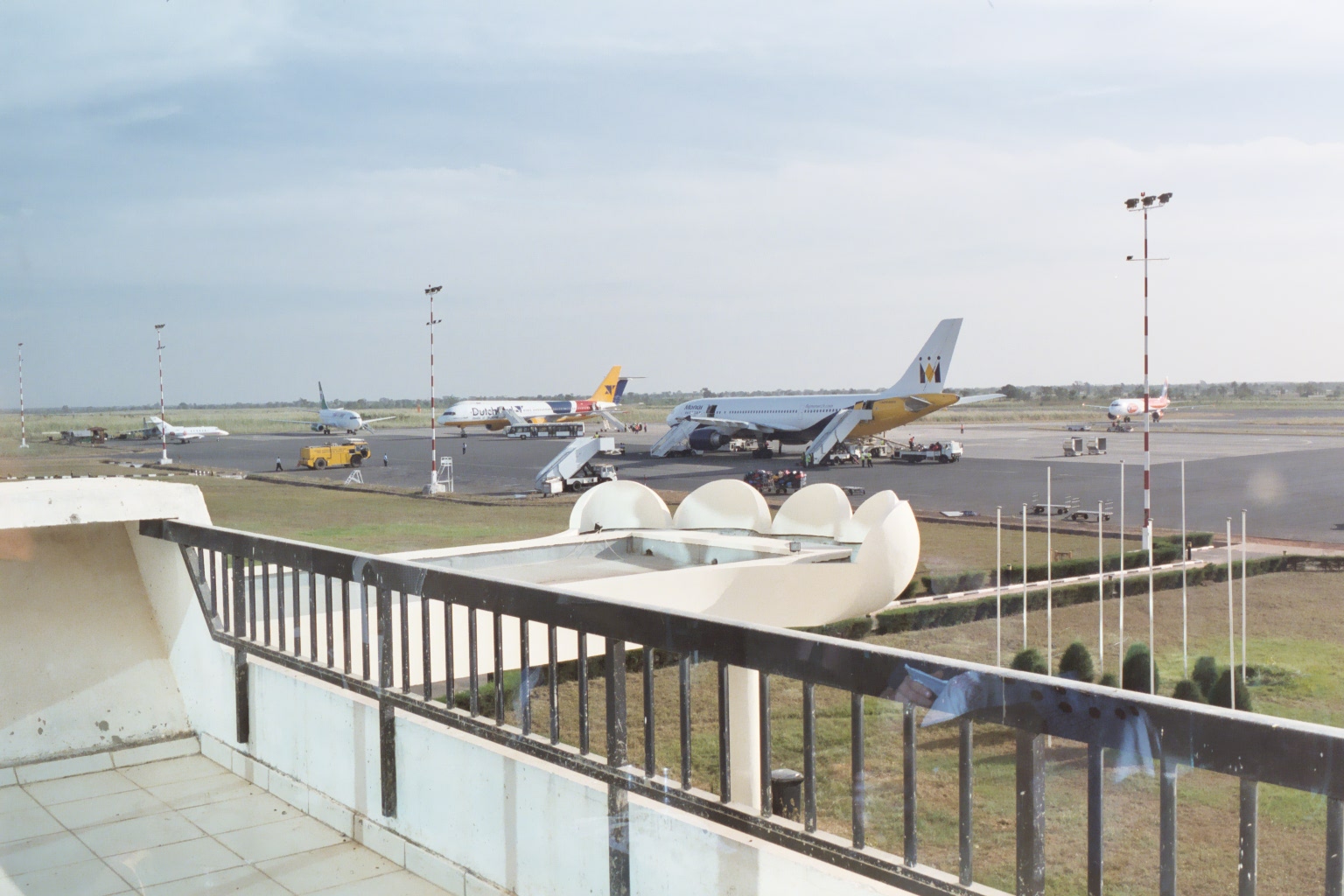 |
This amazingly modern airport, is actually a Spaceport.
Why? Because NASA built this airport. It serves as
an alternate landing site for the Space Shuttle.
You have to walk out to the airplanes. The first thing
that happens when you arrive to the Gambia is
you have to give a -ahem- donation to the staff.
|














